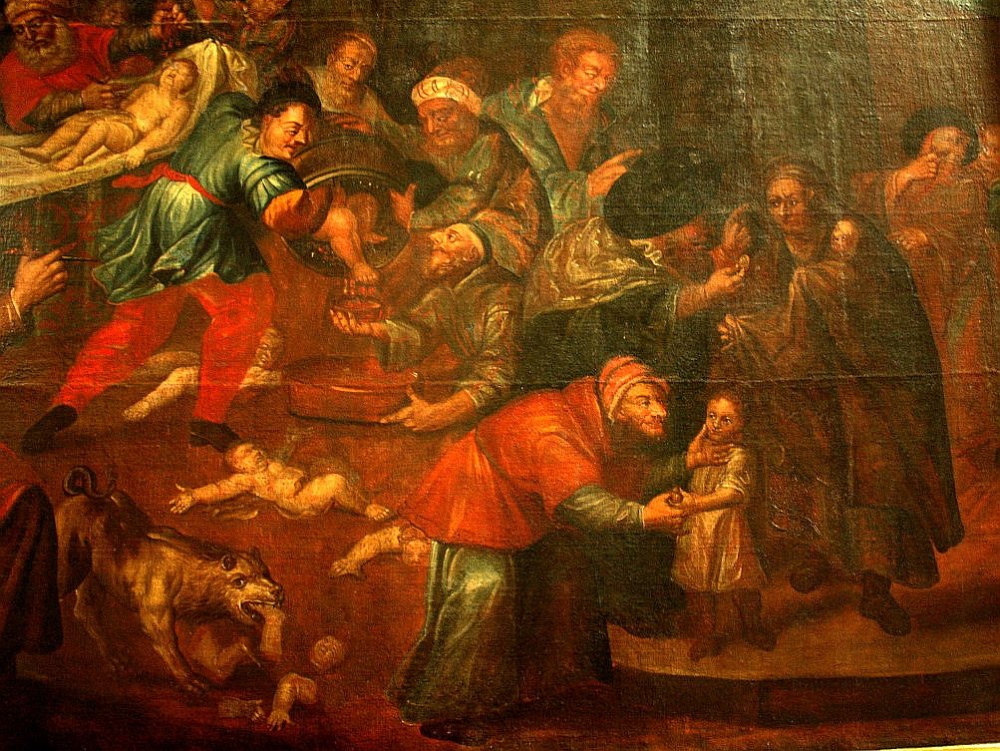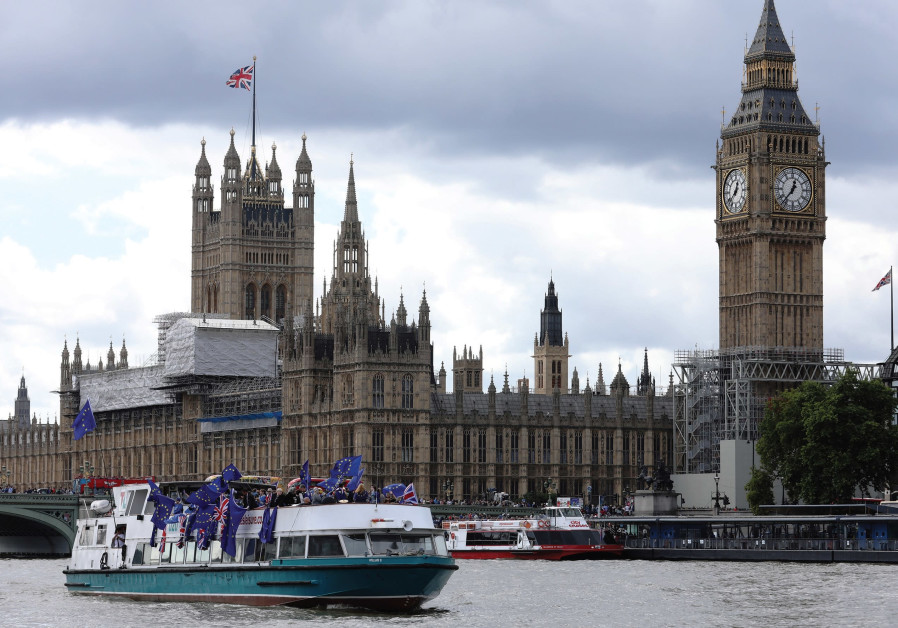 Ksiądz profesor wykłada o żydowskich mordach rytualnych. List Polskiej Rady Chrześcijan i Żydów
Ksiądz profesor wykłada o żydowskich mordach rytualnych. List Polskiej Rady Chrześcijan i Żydów
REDAKCJA
 Obraz przedstawiający rzekomy mord rytualny z katedry w Sandomierzu autorstwa Karola de Prevot (XVIII w.)
Obraz przedstawiający rzekomy mord rytualny z katedry w Sandomierzu autorstwa Karola de Prevot (XVIII w.)
Apelujemy o publiczne zajęcie stanowiska w tej sprawie oraz podjęcie surowych kroków dyscyplinujących wobec osoby głoszącej takie antyżydowskie i antykatolickie twierdzenia – pisze Polska Rada Chrześcijan i Żydów w liście do metropolity lubelskiego abp. dr. hab. Stanisława Budzika i rektora Katolickiego Uniwersytetu Lubelskiego ks. prof. dr. hab. Antoniego Dębińskiego.
Ekscelencjo, Księże Arcybiskupie!
Magnificencjo, Księże Rektorze!
Z rosnącym niepokojem śledzimy narastającą w tym roku aktywność wykładową ks. prof. Tadeusza Guza dotyczącą Żydów i judaizmu. Niektóre wygłaszane przez niego tezy są całkowicie niezgodne z prawdą i absolutnie niedopuszczalne. Dlatego zwracamy się do Księdza Arcybiskupa i Księdza Rektora z prośbą o podjęcie stosownej interwencji.
Podczas swoich wykładów (nagrania dostępne są w wielu miejscach w internecie) ks. Guz wielokrotnie wypowiada tonem eksperta różne opinie sprzeczne ze zdrowym rozsądkiem i z faktami. Naszą szczególną uwagę przykuły słowa profesora Katolickiego Uniwersytetu Lubelskiego Jana Pawła II o żydowskich mordach rytualnych. Cytujemy je spisane dosłownie z nagrania dostępnego w internecie: „My wiemy, kochani państwo, że tych faktów, jakimi były mordy rytualne, nie da się z historii wymazać. Dlaczego? Dlatego, że my, polskie państwo, w naszych archiwach, w ocalałych dokumentach, mamy na przestrzeni różnych wieków – wtedy, kiedy Żydzi żyli razem z naszym narodem polskim – my mamy prawomocne wyroki po mordach rytualnych”.
Absolutnie niedopuszczalne jest, aby opinie o rzekomej prawdziwości mordów rytualnych były tolerowane w przestrzeni publicznej
Jak z pewnością doskonale wiadomo Księdzu Arcybiskupowi i Księdzu Rektorowi, żydowskie mordy rytualne są wytworem antysemickiej fantazji. Prawomocne wyroki polskich sądów na rzekomych sprawcach takich mordów (również wyroki śmierci) zapadały zaś często po tym, jak oskarżeni żydowscy współobywatele poddawani byli torturom.
Najsłynniejszy polski rzekomy mord rytualny to ten „uwieczniony” na obrazie wiszącym w katedrze sandomierskiej. Jest to wierutne kłamstwo. Nie dość bowiem, że żadnego mordu rytualnego nie było, to nawet wręcz odwrotnie – z inicjatywy wpływowych katolickich duchownych w latach 1628, 1698 i 1710-1713 skazano na śmierć Bogu ducha winnych sandomierskich Żydów.
Od stycznia 2014 r., na mocy decyzji bp. Krzysztofa Nitkiewicza, pod obrazem w Sandomierzu wisi tabliczka z – zaproponowanym wiele lat wcześniej przez naszą Radę – wyjaśnieniem: „Obraz ten przedstawia rzekomy mord rytualny, który miałby być dokonany przez sandomierskich Żydów w celu dodania krwi dziecka chrześcijańskiego do macy używanej w czasie Paschy. Wydarzenie to nie jest zgodne z prawdą historyczną, a co więcej nigdy nie mogło mieć miejsca, gdyż prawa judaizmu zabraniają spożywania krwi. Żydzi nie mogli dokonywać i nie dokonywali mordów rytualnych. Z powodu podobnych oskarżeń byli często prześladowani i mordowani, jak to wydarzyło się również w Sandomierzu. Począwszy od XIII wieku papieże zabraniali rozpowszechniania tego rodzaju fałszywych zarzutów i bronili Żydów przed nimi”.
Oskarżenia wobec Żydów o dokonywanie na chrześcijanach mordów rytualnych, choć oficjalnie odrzucane przez Kościół, wciąż, niestety, powracają w wyobraźni części katolików. Absolutnie niedopuszczalne jest więc, aby opinie o rzekomej prawdziwości mordów rytualnych były tolerowane w przestrzeni publicznej. Nie godzi się, aby takie opinie wygłaszał profesor zasłużonej uczelni noszącej imię wielkiego przyjaciela Żydów – papieża Jana Pawła II. Nie do przyjęcia jest, aby wypowiadał je duchowny archidiecezji lubelskiej, na terenie której żyło dawniej tak wielu Żydów, i gdzie tak wiele dobra dokonało się w ostatnich dekadach w dziedzinie dialogu chrześcijańsko-żydowskiego.
Wobec głoszenia takich tez współcześnie może obowiązywać jedynie polityka «zero tolerancji»”
Wiemy, że wypowiedzi ks. Tadeusza Guza również w innych kwestiach są dla Księży nie do zaakceptowania. Świadomi jesteśmy ustnego zalecenia metropolity lubelskiego, aby ks. Guz „powstrzymał się od wypowiedzi na temat Marcina Lutra i reformacji”. Znamy też stanowisko rzecznik prasowej KUL, że wypowiedzi ks. Guza w sprawach ekologii „szkodzą dobremu imieniu uniwersytetu”, ale „są wyrazem indywidualnych poglądów o charakterze pozanaukowym, za które pełną odpowiedzialność bierze ich autor”. W tym przypadku chodzi jednak o kwestię szczególnej wagi – o publiczne podtrzymywanie tezy, która w przeszłości wielokrotnie bezpośrednio doprowadziła do pozbawienia życia niewinnych ludzi.
Wobec głoszenia takich tez współcześnie może obowiązywać jedynie polityka „zero tolerancji” – tym bardziej, że nagrania z wykładami ks. Guza cieszą się dużą popularnością wśród internautów. W tak istotnej sprawie opinia publiczna nie powinna mieć żadnych wątpliwości co do stanowiska Kościoła, a zwłaszcza władz metropolii lubelskiej i uniwersytetu katolickiego jako przełożonych ks. Guza. Apelujemy zatem do Księdza Arcybiskupa i Księdza Rektora o publiczne zajęcie stanowiska w tej sprawie oraz podjęcie surowych kroków dyscyplinujących wobec osoby głoszącej takie – antyżydowskie, ale i antykatolickie, bo odrzucane przez Kościół – twierdzenia.
Informujemy również, że ze względu na wagę sprawy nadamy temu listowi charakter publiczny w kilka dni po wysłaniu do adresatów.
Stanisław Krajewski i Zbigniew Nosowski, współprzewodniczący Polskiej Rady Chrześcijan i Żydów
Warszawa, 13 listopada 2018 r.




